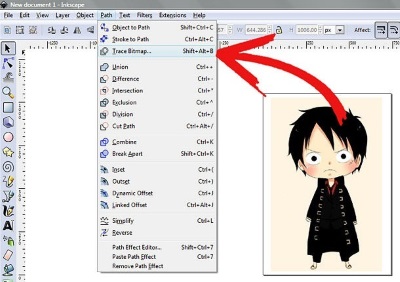

There are many rules and options for this which generally work well. Third it has to make decisions about weathe rto make a smooth curve or a sharp point when the direction of a shapes edge changes.If you ask for a circle you will NOT get a circle, but a rough polygonal representation of a circle, appropriate for the scale of the image being converted. Second it will only generate complex polygons of the shape.

You are better off thresholding the image so as to brovide a clean edge for AutoTrace to trace other regionas and shapes of color.
First it does NOT handle anti-aliased pixels very well. This is a bitmap to vector graphic converter, but it has some limitations. When you ask IM to generate a SVG version of an image it does so by calling the AutoTrace library. IM is a raster (pixel array) image processor, and as such when the IM draw command is used Which is compiled from source on my Ubuntu 9.04 machine. The resulted circles were always black and solid.ġ) Do I really have to write all my drawing commands in one draw argument (like the second example)?Ģ) Can I use graphics settings like stroke, strokewidth and fill to draw svg images? how?ģ) Can I use DIFFERENT colors for the same svg image? how?Ĭopyright: Copyright (C) 1999-2009 ImageMagick Studio LLC However, it didn't respect any of the attributes like fill and stroke. It worked correctly but it generated the last circle onlyĬonvert -size 100x100 -draw 'circle 20,20 10,10 circle 30,30 50,50' xc: test.svgĪnd it generated the two circles correctly. 
Suppress speckles will eliminate any spots, dust, distortion, and other unwanted bits.I'm using ImageMagick command line tool (convert) to generate svg images.įirst, I tried this command to generate an image with two circleĬonvert -size 100x100 -draw 'circle 20,20 10,10' -draw 'circle 30,30 50,50' xc: test.svg.Check “Remove background” to get rid of background, which usually has the lightest color. Extra options: The 'Smooth' option will apply a Gaussian blur before tracing, and “Stack scans” gets rid of holes in path coverage.Grays is like colors, but with shades on the grayscale.
 Colours uses the number in the “Scans” box to determine how many colors to output. Brightness steps allows you to specify the total number of scans. An algorithm is then used to turn those theoretical colors black or white. The “number of colors” setting gives you the opportunity to specify how many colors you’d want in your output were it possible to output in color. Color quantization produces a path based on differences in color. Again, a higher threshold will produce darker output. The threshold settings adjust the darkness of the output. Edge detection will create a path based on differences in the brightness of pixels. The higher the threshold setting, the darker the image will become. Brightness cutoff uses the shade of a pixel to decide whether it should become black or white. Select “single” if you’d like to create a single path from the image, or “multiple” if you’d prefer many overlapping paths. Choose between single and multiple scans. To check out more of his work and projects and designs you can find him and follow him on Twitter. We're grateful to James for this quick tutorial. You can save a SVG with multiple layers of sketches, a sketch for each color! An extremely powerful tool for 3d modeling. It’s that easy! Multiple colored SVG’s are even more interesting. Of 10 Finished! 2D Image or Logo into a 3D Model w James Alday
Colours uses the number in the “Scans” box to determine how many colors to output. Brightness steps allows you to specify the total number of scans. An algorithm is then used to turn those theoretical colors black or white. The “number of colors” setting gives you the opportunity to specify how many colors you’d want in your output were it possible to output in color. Color quantization produces a path based on differences in color. Again, a higher threshold will produce darker output. The threshold settings adjust the darkness of the output. Edge detection will create a path based on differences in the brightness of pixels. The higher the threshold setting, the darker the image will become. Brightness cutoff uses the shade of a pixel to decide whether it should become black or white. Select “single” if you’d like to create a single path from the image, or “multiple” if you’d prefer many overlapping paths. Choose between single and multiple scans. To check out more of his work and projects and designs you can find him and follow him on Twitter. We're grateful to James for this quick tutorial. You can save a SVG with multiple layers of sketches, a sketch for each color! An extremely powerful tool for 3d modeling. It’s that easy! Multiple colored SVG’s are even more interesting. Of 10 Finished! 2D Image or Logo into a 3D Model w James Alday








 0 kommentar(er)
0 kommentar(er)
